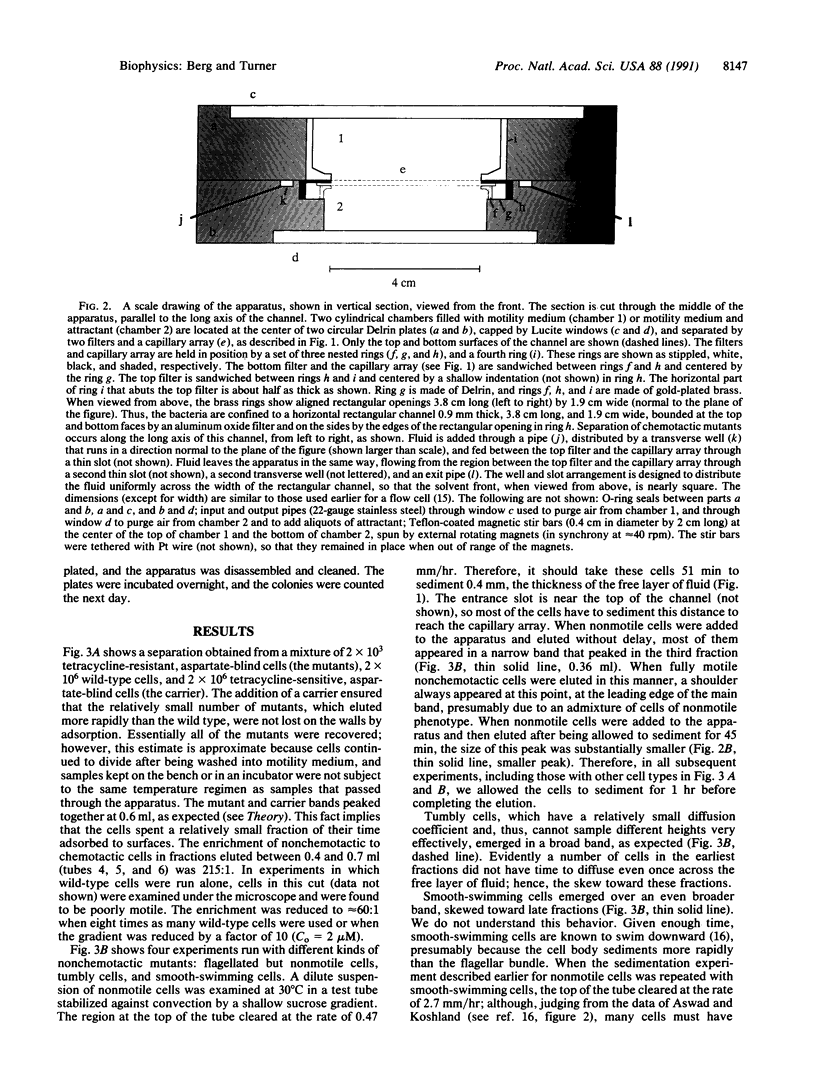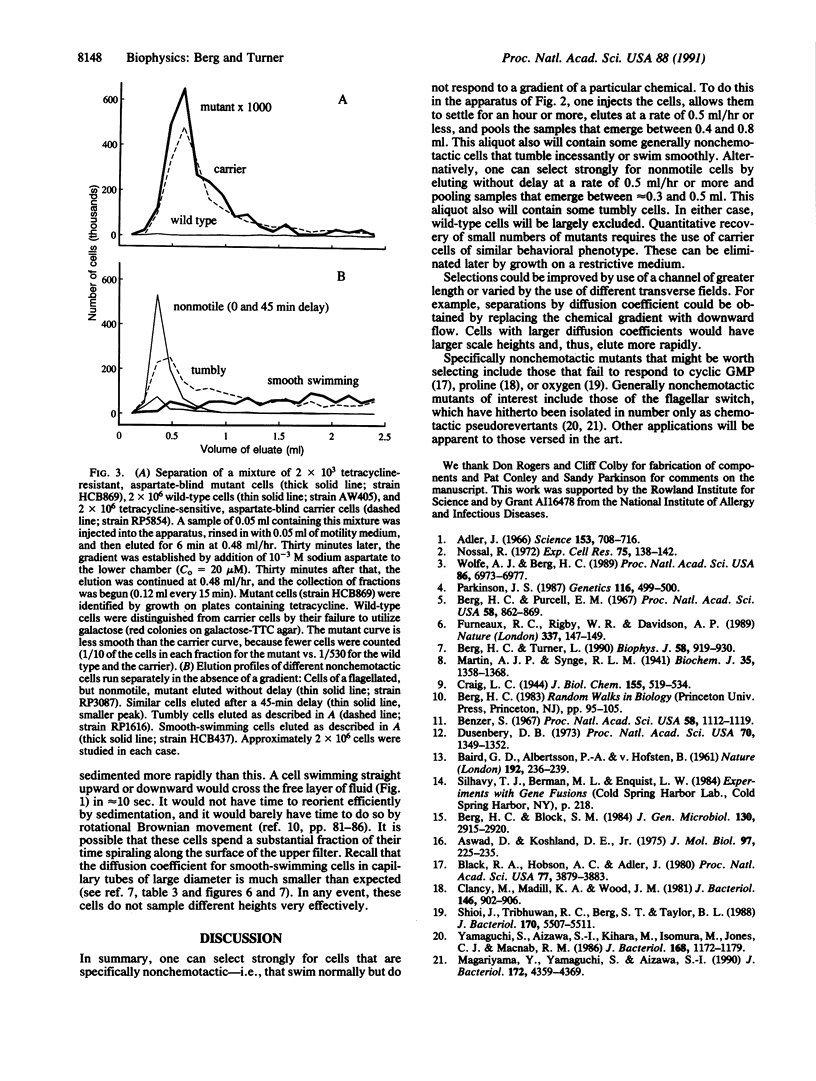Abstract
We have developed a chromatographic method for isolating bacterial cells that are motile but nonchemotactic. Separation of strains of different phenotype occurs along a thin horizontal channel between two stirred chambers, the lower one containing a chemical attractant. The channel is bounded above and below by rigid filters, permeable to the attractant but not to the bacteria. The lower part of the channel is occupied by a porous plate comprising a vertical array of capillary tubes. An aliquot of cells is injected at one end of the channel and eluted by continuous flow of cell-free medium. Fluid leaving the other end of the channel is collected in a fraction collector. Cells that respond to the gradient swim to the bottom of the channel where they are retarded by the capillary array. Nonmotile cells sink to the bottom and are trapped in a similar manner. Motile cells that fail to respond to the gradient diffuse across the full height of the channel and, thus, travel through the apparatus at the average velocity of the eluent. When mixed with wild-type cells at a ratio of 1:1000 and subjected to an aspartate gradient, aspartate-blind cells were recovered quantitatively. The enrichment was approximately 200 to 1. The wild-type cells that survived the selection had a poorly motile phenotype.
Full text
PDF



Images in this article
Selected References
These references are in PubMed. This may not be the complete list of references from this article.
- Adler J. Chemotaxis in bacteria. Science. 1966 Aug 12;153(3737):708–716. doi: 10.1126/science.153.3737.708. [DOI] [PubMed] [Google Scholar]
- Aswad D., Koshland D. E., Jr Isolation, characterization and complementation of Salmonella typhimurium chemotaxis mutants. J Mol Biol. 1975 Sep 15;97(2):225–235. doi: 10.1016/s0022-2836(75)80036-2. [DOI] [PubMed] [Google Scholar]
- BAIRD G. D., ALBERTSSON P. A., von HOFSTEN Separation of bacteria by counter-current distribution. Nature. 1961 Oct 21;192:236–239. doi: 10.1038/192236a0. [DOI] [PubMed] [Google Scholar]
- Benzer S. BEHAVIORAL MUTANTS OF Drosophila ISOLATED BY COUNTERCURRENT DISTRIBUTION. Proc Natl Acad Sci U S A. 1967 Sep;58(3):1112–1119. doi: 10.1073/pnas.58.3.1112. [DOI] [PMC free article] [PubMed] [Google Scholar]
- Berg H. C., Block S. M. A miniature flow cell designed for rapid exchange of media under high-power microscope objectives. J Gen Microbiol. 1984 Nov;130(11):2915–2920. doi: 10.1099/00221287-130-11-2915. [DOI] [PubMed] [Google Scholar]
- Berg H. C., Purcell E. M. A method for separating according to mass a mixture of macromolecules or small particles suspended in a fluid, I. Theory. Proc Natl Acad Sci U S A. 1967 Sep;58(3):862–869. doi: 10.1073/pnas.58.3.862. [DOI] [PMC free article] [PubMed] [Google Scholar]
- Berg H. C., Turner L. Chemotaxis of bacteria in glass capillary arrays. Escherichia coli, motility, microchannel plate, and light scattering. Biophys J. 1990 Oct;58(4):919–930. doi: 10.1016/S0006-3495(90)82436-X. [DOI] [PMC free article] [PubMed] [Google Scholar]
- Black R. A., Hobson A. C., Adler J. Involvement of cyclic GMP in intracellular signaling in the chemotactic response of Escherichia coli. Proc Natl Acad Sci U S A. 1980 Jul;77(7):3879–3883. doi: 10.1073/pnas.77.7.3879. [DOI] [PMC free article] [PubMed] [Google Scholar]
- Clancy M., Madill K. A., Wood J. M. Genetic and biochemical requirements for chemotaxis to L-proline in Escherichia coli. J Bacteriol. 1981 Jun;146(3):902–906. doi: 10.1128/jb.146.3.902-906.1981. [DOI] [PMC free article] [PubMed] [Google Scholar]
- Dusenbery D. B. Countercurrent separation: a new method for studying behavior of small aquatic organisms. Proc Natl Acad Sci U S A. 1973 May;70(5):1349–1352. doi: 10.1073/pnas.70.5.1349. [DOI] [PMC free article] [PubMed] [Google Scholar]
- Magariyama Y., Yamaguchi S., Aizawa S. Genetic and behavioral analysis of flagellar switch mutants of Salmonella typhimurium. J Bacteriol. 1990 Aug;172(8):4359–4369. doi: 10.1128/jb.172.8.4359-4369.1990. [DOI] [PMC free article] [PubMed] [Google Scholar]
- Martin A. J., Synge R. L. A new form of chromatogram employing two liquid phases: A theory of chromatography. 2. Application to the micro-determination of the higher monoamino-acids in proteins. Biochem J. 1941 Dec;35(12):1358–1368. doi: 10.1042/bj0351358. [DOI] [PMC free article] [PubMed] [Google Scholar]
- Nossal R. Growth and movement of rings of chemotactic bacteria. Exp Cell Res. 1972 Nov;75(1):138–142. doi: 10.1016/0014-4827(72)90529-0. [DOI] [PubMed] [Google Scholar]
- Parkinson J. S. Doing behavioral genetics with bacteria. Genetics. 1987 Aug;116(4):499–500. doi: 10.1093/genetics/116.4.499. [DOI] [PMC free article] [PubMed] [Google Scholar]
- Shioi J., Tribhuwan R. C., Berg S. T., Taylor B. L. Signal transduction in chemotaxis to oxygen in Escherichia coli and Salmonella typhimurium. J Bacteriol. 1988 Dec;170(12):5507–5511. doi: 10.1128/jb.170.12.5507-5511.1988. [DOI] [PMC free article] [PubMed] [Google Scholar]
- Wolfe A. J., Berg H. C. Migration of bacteria in semisolid agar. Proc Natl Acad Sci U S A. 1989 Sep;86(18):6973–6977. doi: 10.1073/pnas.86.18.6973. [DOI] [PMC free article] [PubMed] [Google Scholar]
- Yamaguchi S., Aizawa S., Kihara M., Isomura M., Jones C. J., Macnab R. M. Genetic evidence for a switching and energy-transducing complex in the flagellar motor of Salmonella typhimurium. J Bacteriol. 1986 Dec;168(3):1172–1179. doi: 10.1128/jb.168.3.1172-1179.1986. [DOI] [PMC free article] [PubMed] [Google Scholar]




